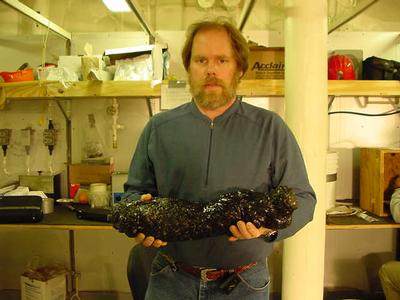20 August, 2001
August 20, 2001
Popping Rocks and Lava Tubes???
This morning the science lab was abuzz with excited scientists. Two dredges
came up in the early hours this morning that were very interesting, to say
the least.
Keeping in mind the Gakkel Ridge is the slowest spreading and least
volcanically active ridge on the planet, finding fresh volcanic rock could
be difficult. However, the rocks that came up in recent dredges show
evidence that it may be otherwise. In dredge #26, "popping rocks" came up.
These are rocks that form by the quick cooling of magma. Magma has gas
under high pressure that is trapped when it solidifies. When these rocks
are then brought from the ocean floor to the surface, the pressure on them
is decreased and the gas wants to escape. This can cause the rocks to make
popping noises and actually move and break! Several scientists observed
this unique action early this morning.
On dredge #27, another batch of fresh volcanic rocks were brought to the
surface. These rocks, called "lava tubes", formed when lava erupted onto
the ocean floor and cooled when it hit the water. The cooling occurred such
that the rocks grew slowly upward in a pillar-like manner. The lava tubes
recovered today were smooth, shiny, and covered with large crystals. They
ranged in size from a few inches to a few feet. To bring a 2-foot long lava
tube up in a dredge without it breaking apart was quite miraculous!
Part of the excitement of being here for me is discovering the undiscovered.
We seem to have found so many amazing things in our 3 weeks at sea, and our
mission is only 1/3 complete. Who knows what other amazing discoveries
await us!

<> Dr. Dave Graham holds a lava tube recovered from a dredge that he supervised.
Contact the TEA in the field at
.
If you cannot connect through your browser, copy the
TEA's e-mail address in the "To:" line of
your favorite e-mail package.
|
